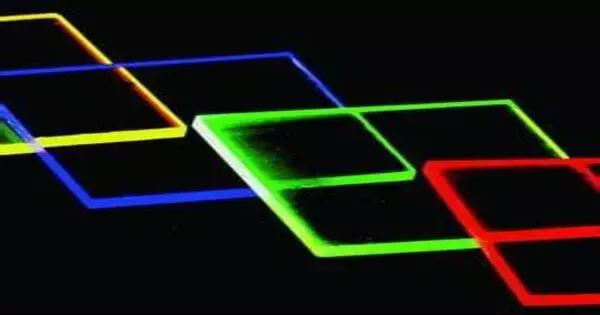A luminescent solar concentrator (LSC) is a device that concentrates radiation, specifically solar radiation, in order to generate electricity. It is a device used to improve the efficiency of solar energy capture. Luminescent solar concentrators work on the principle of collecting radiation over a large area, converting it via luminescence (specifically fluorescence), and directing the generated radiation into a relatively small output target. It is a type of solar energy harvesting technology that uses the principles of luminescence and light concentration to convert sunlight into electricity.
Design
Initially, designs consisted of parallel thin, flat layers of alternating luminescent and transparent materials, positioned to collect incoming radiation on their (broader) faces and emit concentrated radiation around their (narrower) edges. Typically, the device would direct concentrated radiation onto solar cells in order to generate electricity. Other configurations (such as doped or coated optical fibers or contoured stacks of alternating layers) may be more appropriate for specific applications.
The basic components of a luminescent solar concentrator typically include:
- Transparent Matrix: The LSC consists of a transparent material, often made of acrylic or glass, that serves as a light-guiding medium. This material contains luminescent molecules (also known as fluorophores) dispersed within it.
- Luminescent Molecules: These are special materials capable of absorbing sunlight and re-emitting it at a longer wavelength (lower energy) through a process called luminescence or fluorescence. The emitted light is trapped and guided within the transparent matrix due to total internal reflection.
- Solar Cells: At the edges or sides of the LSC, photovoltaic solar cells are placed to capture the guided light and convert it into electricity.
Here’s how the luminescent solar concentrator works:
- Sunlight Absorption: When sunlight strikes the LSC’s surface, the luminescent molecules embedded within the transparent matrix absorb some of the incident light.
- Luminescence: The luminescent molecules re-emit the absorbed light at a longer wavelength after absorbing it. Through multiple internal reflections, this re-emitted light travels through the transparent matrix.
- Light Guiding: The emitted light is trapped and guided through the matrix by the phenomenon of total internal reflection, traveling towards the edges of the LSC.
- Solar Cell Conversion: Photovoltaic solar cells are positioned at the LSC’s edges to capture the guided light. These solar cells convert the trapped light into electrical energy, resulting in the production of electricity.
Luminescent solar concentrators have several advantages, including the fact that they are inexpensive, lightweight, and potentially transparent, making them suitable for a variety of applications such as windows, facades, and other building-integrated photovoltaic systems. They do, however, have some limitations, such as losses caused by the re-absorption of emitted light and difficulties in achieving high optical efficiencies.
















